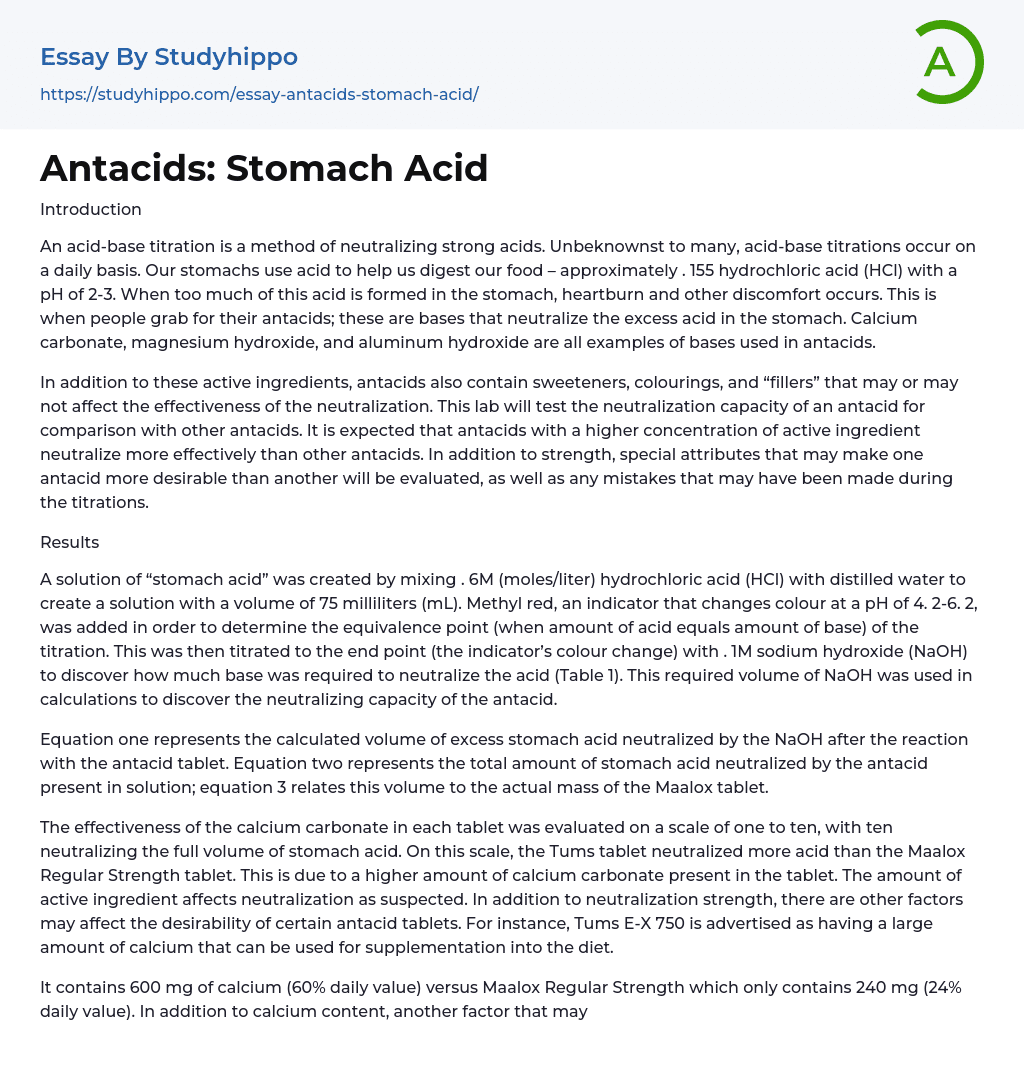Introduction
An acid-base titration is a method of neutralizing strong acids. Unbeknownst to many, acid-base titrations occur on a daily basis. Our stomachs use acid to help us digest our food – approximately . 155 hydrochloric acid (HCl) with a pH of 2-3. When too much of this acid is formed in the stomach, heartburn and other discomfort occurs. This is when people grab for their antacids; these are bases that neutralize the excess acid in the stomach. Calcium carbonate, magnesium hydroxide, and aluminum hydroxide are all examples of bases used in antacids.
In addition to these active ingredients, antacids also contain sweeteners, colourings, and “fillers” that may or may not affect the effectiveness of the neutralization. This lab will test the neutralization capacity of an antacid for compariso
...n with other antacids. It is expected that antacids with a higher concentration of active ingredient neutralize more effectively than other antacids. In addition to strength, special attributes that may make one antacid more desirable than another will be evaluated, as well as any mistakes that may have been made during the titrations.
Results
A solution of “stomach acid” was created by mixing . 6M (moles/liter) hydrochloric acid (HCl) with distilled water to create a solution with a volume of 75 milliliters (mL). Methyl red, an indicator that changes colour at a pH of 4. 2-6. 2, was added in order to determine the equivalence point (when amount of acid equals amount of base) of the titration. This was then titrated to the end point (the indicator’s colour change) with . 1M sodium hydroxide (NaOH) to discover how much base was
required to neutralize the acid (Table 1). This required volume of NaOH was used in calculations to discover the neutralizing capacity of the antacid.
Equation one represents the calculated volume of excess stomach acid neutralized by the NaOH after the reaction with the antacid tablet. Equation two represents the total amount of stomach acid neutralized by the antacid present in solution; equation 3 relates this volume to the actual mass of the Maalox tablet.
The effectiveness of the calcium carbonate in each tablet was evaluated on a scale of one to ten, with ten neutralizing the full volume of stomach acid. On this scale, the Tums tablet neutralized more acid than the Maalox Regular Strength tablet. This is due to a higher amount of calcium carbonate present in the tablet. The amount of active ingredient affects neutralization as suspected. In addition to neutralization strength, there are other factors may affect the desirability of certain antacid tablets. For instance, Tums E-X 750 is advertised as having a large amount of calcium that can be used for supplementation into the diet.
It contains 600 mg of calcium (60% daily value) versus Maalox Regular Strength which only contains 240 mg (24% daily value). In addition to calcium content, another factor that may affect the desirability includes the types of sugars included in each tablet. Tums contains sucrose, more commonly known as sugar, in comparison to Maalox, which contains aspartame, an artificial sweetener. Some buyers may be watching their sugar intake (Tums contains 2g of sugar), whereas others may not want to ingest aspartame due to harmful side effects.
During the titrations, there was one
specific error that was made that could have affected the data. For the three titrations of stomach acid with sodium hydroxide, the final titration had a smaller volume of HCl, as there was no more solution available. This lowered the average immensely, thus the volume of NaOH used in the titration that best represented the “average” was used (12 mL, Titration #2) in calculations. Other errors that could occur include the accidental use of an indicator other than methyl red.
Other indicators such as phenolphthalein and methyl orange change colours in different pH ranges than methyl red. For instance, a change in colour at a pH of 3. 1 - 4. 4 (methyl orange) or 8. 2 – 10 (phenolphthalein) would represent a different ratio of acid/base. Thus, the end point of a phenolphthalein titration would have a more basic solution that that of methyl red, and the end point of a methyl orange solution would have a more acidic solution than that of methyl red. These differences would change the perceived value of acid neutralized by the antacid tablets.
- Acid Rain essays
- Acid essays
- Calcium essays
- Carbohydrate essays
- Carbon essays
- Chemical Bond essays
- Chemical Reaction essays
- Chemical reactions essays
- Chromatography essays
- Concentration essays
- Copper essays
- Diffusion essays
- Ethanol essays
- Hydrogen essays
- Organic Chemistry essays
- Osmosis essays
- Periodic Table essays
- Ph essays
- Salt essays
- Sodium essays
- Titration essays
- John Locke essays
- 9/11 essays
- A Good Teacher essays
- A Healthy Diet essays
- A Modest Proposal essays
- A&P essays
- Academic Achievement essays
- Achievement essays
- Achieving goals essays
- Admission essays
- Advantages And Disadvantages Of Internet essays
- Alcoholic drinks essays
- Ammonia essays
- Analytical essays
- Ancient Olympic Games essays
- APA essays
- Arabian Peninsula essays
- Argument essays
- Argumentative essays
- Art essays
- Atlantic Ocean essays
- Auto-ethnography essays
- Autobiography essays
- Ballad essays
- Batman essays
- Binge Eating essays
- Black Power Movement essays
- Blogger essays
- Body Mass Index essays




